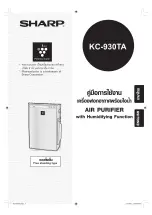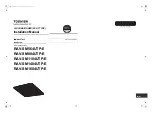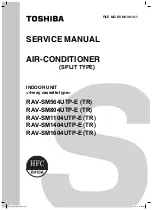
5
GB
D
F
I
NL
E
P
GR
RU
TR
Contents
1. Safety precautions
1.1. Before installation and electric work
s
Before installing the unit, make sure you read all the “Safety
precautions”.
s
The “Safety precautions” provide very important points re-
garding safety. Make sure you follow them.
Symbols used in the text
Warning:
Describes precautions that should be observed to prevent danger of injury
or death to the user.
Caution:
Describes precautions that should be observed to prevent damage to the
unit.
Symbols used in the illustrations
: Indicates an action that must be avoided.
: Indicates that important instructions must be followed.
: Indicates a part which must be grounded.
: Beware of electric shock. (This symbol is displayed on the main unit label.)
<Color: yellow>
Warning:
Carefully read the labels affixed to the main unit.
Warning:
•
Ask the dealer or an authorized technician to install the air conditioner.
- Improper installation by the user may result in water leakage, electric shock,
or fire.
•
Install the unit at a place that can withstand its weight.
- Inadequate strength may cause the unit to fall down, resulting in injuries.
•
Use the specified cables for wiring. Make the connections securely so
that the outside force of the cable is not applied to the terminals.
- Inadequate connection and fastening may generate heat and cause a fire.
•
Prepare for rain and other moisture and earthquakes and install the unit
at the specified place.
- Improper installation may cause the unit to topple and result in injury.
•
Always use an filter and other accessories specified by Mitsubishi Elec-
tric.
- Ask an authorized technician to install the accessories. Improper installation
by the user may result in water leakage, electric shock, or fire.
•
Never repair the unit. If the air conditioner must be repaired, consult the
dealer.
- If the unit is repaired improperly, water leakage, electric shock, or fire may
result.
•
If refrigerant gas leaks during installation work, ventilate the room.
- If the refrigerant gas comes into contact with a flame, poisonous gases will
be released.
•
Install the air conditioner according to this Installation Manual.
- If the unit is installed improperly, water leakage, electric shock, or fire may
result.
•
Have all electric work done by a licensed electrician according to “Elec-
tric Facility Engineering Standard” and “Interior Wire Regulations”and
the instructions given in this manual and always use a special circuit.
- If the power source capacity is inadequate or electric work is performed im-
properly, electric shock and fire may result.
•
Securely install the heat source unit terminal cover (panel).
- If the terminal cover (panel) is not installed properly, dust or water may enter
the heat source unit and fire or electric shock may result.
•
When installing and moving the air conditioner to another site, do not
charge the it with a refrigerant different from the refrigerant (R407C) speci-
fied on the unit.
- If a different refrigerant or air is mixed with the original refrigerant, the refrig-
erant cycle may malfunction and the unit may be damaged.
•
If the air conditioner is installed in a small room, measures must be taken
to prevent the refrigerant concentration from exceeding the safety limit
even if the refrigerant should leak.
- Consult the dealer regarding the appropriate measures to prevent the safety
limit from being exceeded. Should the refrigerant leak and cause the safety
limit to be exceeded, hazards due to lack of oxygen in the room could result.
•
When moving and reinstalling the air conditioner, consult the dealer or
an authorized technician.
- If the air conditioner is installed improperly, water leakage, electric shock, or
fire may result.
•
After completing installation work, make sure that refrigerant gas is not
leaking.
- If the refrigerant gas leaks and is exposed to a fan heater, stove, oven, or
other heat source, it may generate noxious gases.
•
Do not reconstruct or change the settings of the protection devices.
- If the pressure switch, thermal switch, or other protection device is shorted
and operated forcibly, or parts other than those specified by Mitsubishi Elec-
tric are used, fire or explosion may result.
•
To dispose of this product, consult your dealer.
•
The installer and system specialist shall secure safety against leakage
according to local regulation or standards.
- Following standards may be applicable if local regulation are not available.
•
Pay a special attention to the place, such as a basement, etc. where re-
frigeration gas can stay, since refrigeration is heavier than the air.
1.2. Precautions for devices that use R407C
refrigerant
Caution:
•
Do not use the existing refrigerant piping.
- The old refrigerant and refrigerator oil in the existing piping contains a large
amount of chlorine which may cause the refrigerator oil of the new unit to
deteriorate.
•
Use refrigerant piping made of phosphorus deoxidized copper and cop-
per alloy seamless pipes and tubes. In addition, be sure that the inner
and outer surfaces of the pipes are clean and free of hazardous sulphur,
oxides, dust/dirt, shaving particles, oils, moisture, or any other contami-
nant.
- Contaminants on the inside of the refrigerant piping may cause the refriger-
ant residual oil to deteriorate.
•
Store the piping to be used during installation indoors and keep both
ends of the piping sealed until just before brazing. (Store elbows and
other joints in a plastic bag.)
- If dust, dirt, or water enters the refrigerant cycle, deterioration of the oil and
compressor trouble may result.
•
Use ester oil, ether oil or alkylbenzene (small amount) as the refrigerator
oil to coat flares and flange connections.
- The refrigerator oil will degrade if it is mixed with a large amount of mineral
oil.
•
Use liquid refrigerant to fill the system.
- If gas refrigerant is used to seal the system, the composition of the refriger-
ant in the cylinder will change and performance may drop.
1. Safety precautions ...................................................................................... 5
1.1. Before installation and electric work .......................................... 5
1.2. Precautions for devices that use R407C refrigerant .................. 5
1.3. Before getting installed .............................................................. 6
1.4. Before getting installed (moved) - electrical work ...................... 6
1.5. Before starting the test run ........................................................ 6
2. Specifications .............................................................................................. 6
3. Confirmation of parts attached ................................................................... 6
4. Lifting method and weight of product .......................................................... 7
5. Installation of unit and service space .......................................................... 7
5.1. Installation ................................................................................. 7
5.2. Service space ............................................................................ 7
6. Water pipe installation ................................................................................. 7
6.1. Precautions during installation .................................................. 7
6.2. Insulation installation ................................................................. 7
6.3. Water processing and water quality control ............................... 7
6.4. Pump interlock ........................................................................... 8
7. Refrigerant piping installation ..................................................................... 8
7.1. Caution ...................................................................................... 8
7.2. Refrigerant piping system .......................................................... 8
8. Additional refrigerant charge ....................................................................... 8
8.1. Calculation of Additional Refrigerant Charge ............................ 8
8.2. Caution for piping connection/valve operation ........................... 9
8.3. Airtight test, evacuation, and refrigerant charging ..................... 9
8.4. Thermal insulation of refrigerant piping ................................... 10
9. Wiring ........................................................................................................ 11
9.1. Caution .................................................................................... 11
9.2. Control box and connecting position of wiring ......................... 11
9.3. Wiring transmission cables ...................................................... 11
9.4. Wiring of main power supply and equipment capacity ............ 12
10. Test run ..................................................................................................... 12
10.1. The following phenomena do not represent trouble
(emergency) ............................................................................ 12































